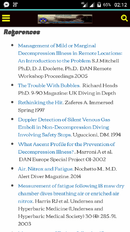packrat12
Contributor
No, you missed the point again. The point here is that breathing EAN not to prevent DCS during recreational diving but just for the heck of breathing EAN doesn't make sense.
I've seen 3 arguments here for breathing EAN just for the heck of it:
1. Because it is available. This argument is irrational, so is not worth discussing. As for the price, my estimate is that diving NITROX adds on average about 5% to you diving cost (for example, $150 on our Aggressor trip, etc). This makes it certainly non-negligible in mathematical sense; whether this is negligible or not in economic sense is up to you to decide.
2. Because it feels good. I disagree with this one based on my personal experience. I suspect that, most likely, the believers fell into the trap of small numbers statistics. They got tired once diving on air for some unrelated reasons, then felt good next time diving on NITROX and came to wrong conclusion. However, it is entirely possible that there are indeed 2 kinds of people who respond differently to EAN. If this is so, this can be proved in a double-blind trial. Fatigue can be actually measured, not just felt, so there should be no problems running such trial.
3. N2 bubbles formed during recreational (rec) diving, even w/o DCS symptoms, are still harmful and result in tissue stress. So breathing NITROX reduces this effect. Well, if this is so, there should be some stats on negative effect of rec scuba diving on human health by now. Also, tissue stress has its markers that can be measured but no such data exist so far for rec divers.
tarponchik - What you are really saying is that there is no disadvantage to nitrox other than cost. Advantages are arguable. One of my advantages, I hate switching back and forth. Much easier for me just to deal with nitrox. I will get some advantages as I go deeper as a bonus.
As for cost, I have spent $3000 + on the trip, airfare, lost time at work, parking, driving, tips, food etc - I do not think $150 is going to break my bank. If all we are doing is 30' dives, I would probably not spend that kind of money on that trip anyway, let alone nitrox. Now I have nitrox and just do not worry about it no matter what diving profiles I have. As for pulmonary, recreational divers have a hard time getting to that risk level. It can be done on a live aboard or many repetitive days of diving but I think the overall advantages outweigh the issues for each individual dive.





